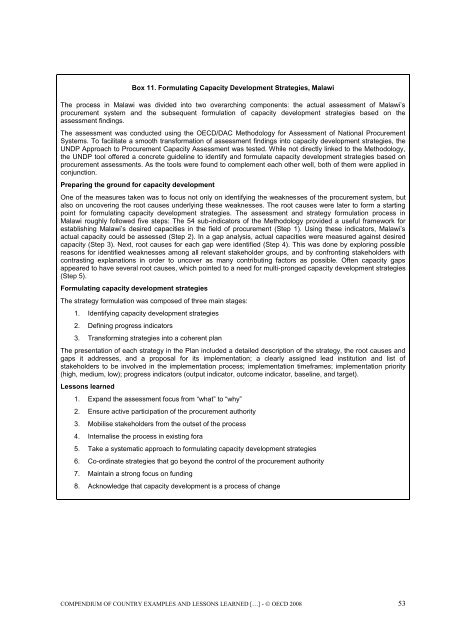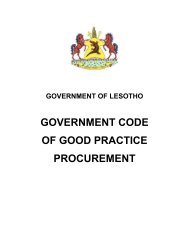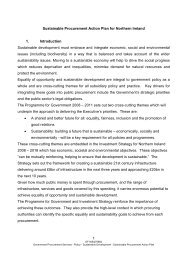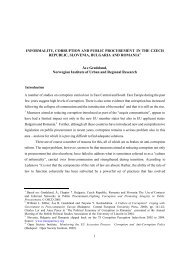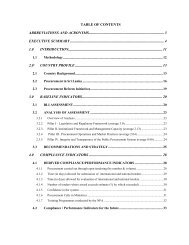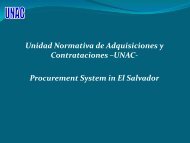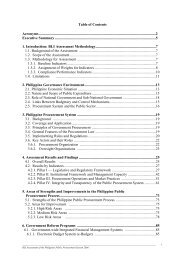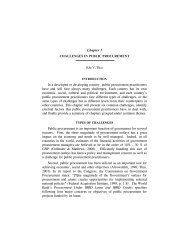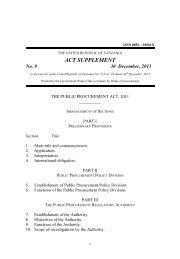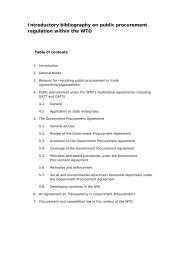Compendium of Country Examples and Lessons Learned from ...
Compendium of Country Examples and Lessons Learned from ...
Compendium of Country Examples and Lessons Learned from ...
Create successful ePaper yourself
Turn your PDF publications into a flip-book with our unique Google optimized e-Paper software.
Box 11. Formulating Capacity Development Strategies, MalawiThe process in Malawi was divided into two overarching components: the actual assessment <strong>of</strong> Malawi’sprocurement system <strong>and</strong> the subsequent formulation <strong>of</strong> capacity development strategies based on theassessment findings.The assessment was conducted using the OECD/DAC Methodology for Assessment <strong>of</strong> National ProcurementSystems. To facilitate a smooth transformation <strong>of</strong> assessment findings into capacity development strategies, theUNDP Approach to Procurement Capacity Assessment was tested. While not directly linked to the Methodology,the UNDP tool <strong>of</strong>fered a concrete guideline to identify <strong>and</strong> formulate capacity development strategies based onprocurement assessments. As the tools were found to complement each other well, both <strong>of</strong> them were applied inconjunction.Preparing the ground for capacity developmentOne <strong>of</strong> the measures taken was to focus not only on identifying the weaknesses <strong>of</strong> the procurement system, butalso on uncovering the root causes underlying these weaknesses. The root causes were later to form a startingpoint for formulating capacity development strategies. The assessment <strong>and</strong> strategy formulation process inMalawi roughly followed five steps: The 54 sub-indicators <strong>of</strong> the Methodology provided a useful framework forestablishing Malawi’s desired capacities in the field <strong>of</strong> procurement (Step 1). Using these indicators, Malawi’sactual capacity could be assessed (Step 2). In a gap analysis, actual capacities were measured against desiredcapacity (Step 3). Next, root causes for each gap were identified (Step 4). This was done by exploring possiblereasons for identified weaknesses among all relevant stakeholder groups, <strong>and</strong> by confronting stakeholders withcontrasting explanations in order to uncover as many contributing factors as possible. Often capacity gapsappeared to have several root causes, which pointed to a need for multi-pronged capacity development strategies(Step 5).Formulating capacity development strategiesThe strategy formulation was composed <strong>of</strong> three main stages:1. Identifying capacity development strategies2. Defining progress indicators3. Transforming strategies into a coherent planThe presentation <strong>of</strong> each strategy in the Plan included a detailed description <strong>of</strong> the strategy, the root causes <strong>and</strong>gaps it addresses, <strong>and</strong> a proposal for its implementation; a clearly assigned lead institution <strong>and</strong> list <strong>of</strong>stakeholders to be involved in the implementation process; implementation timeframes; implementation priority(high, medium, low); progress indicators (output indicator, outcome indicator, baseline, <strong>and</strong> target).<strong>Lessons</strong> learned1. Exp<strong>and</strong> the assessment focus <strong>from</strong> “what” to “why”2. Ensure active participation <strong>of</strong> the procurement authority3. Mobilise stakeholders <strong>from</strong> the outset <strong>of</strong> the process4. Internalise the process in existing fora5. Take a systematic approach to formulating capacity development strategies6. Co-ordinate strategies that go beyond the control <strong>of</strong> the procurement authority7. Maintain a strong focus on funding8. Acknowledge that capacity development is a process <strong>of</strong> changeCOMPENDIUM OF COUNTRY EXAMPLES AND LESSONS LEARNED […] - OECD 2008 53


